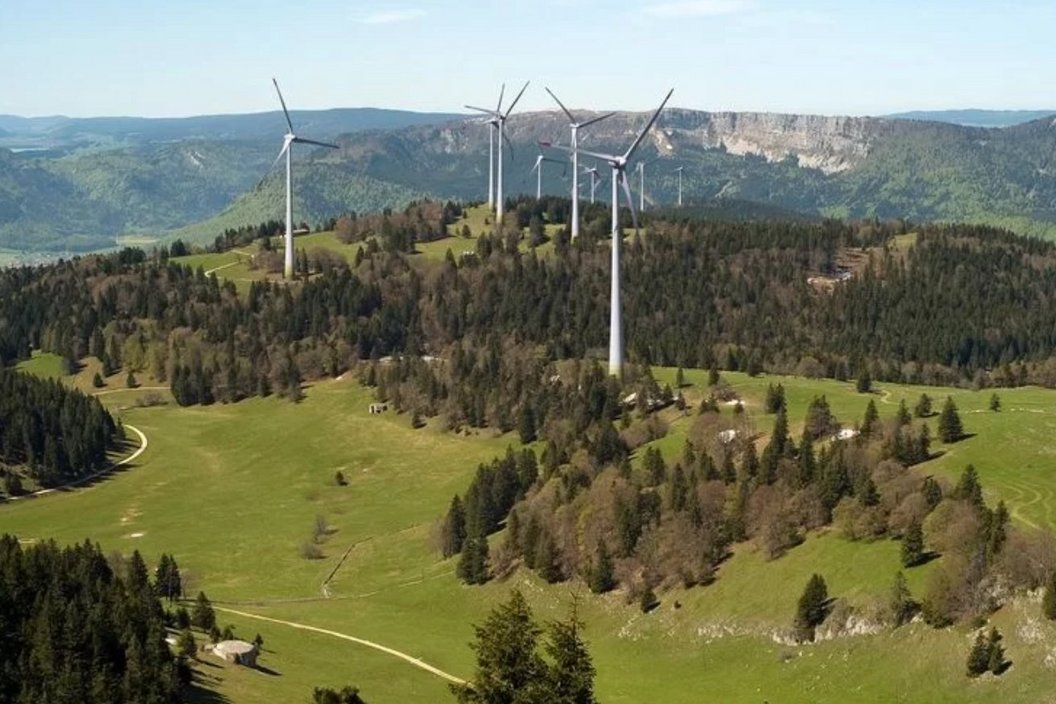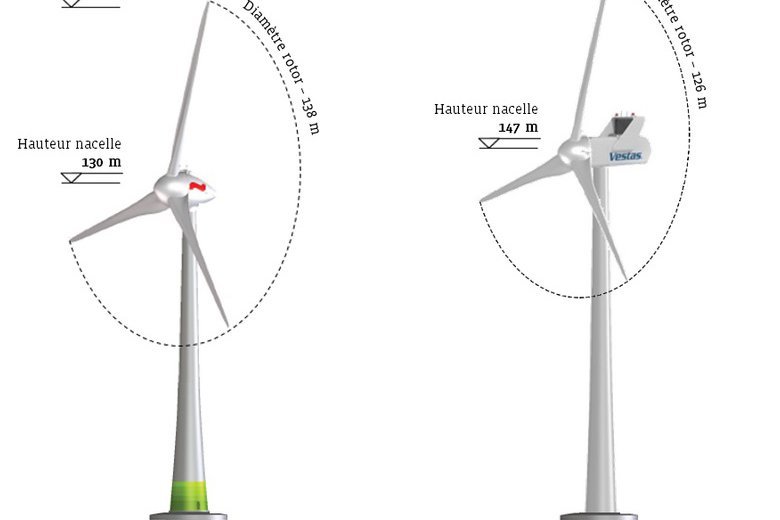News about the project
Stay up to date and read the latest news about the Bel Coster project
The Bel Coster wind farm will see the installation of 9 wind turbines on the Suchet ridge in the Jura-Nord Vaud district. With its renewable energy production, it will contribute to supplying the canton of Vaud locally and sustainably.
Environmentally-friendly wind power technology is perfectly suited to the Jura-Nord Vaud region. The region's wind conditions and topography are conducive to responsible wind power development that best protects the interests of the local population.
The Bel Coster project involves the installation of nine wind turbines, each with a capacity of 3 to 4 MW. It is being developed by the Lausanne-based energy group Alpiq in partnership with the communes of l'Abergement, Ballaigues and Lignerolle. It is one of the projects selected by the Canton of Vaud in its cantonal master plan.
Stay up to date and read the latest news about the Bel Coster project

Jura-Nord, Vaud
9 turbines, Type to be defined
27 - 36 MW
22'000 households, 65 - 90 GWh/year
85 t/day
The future wind farm will generate between 65 and 90 million kWh per year, depending on the type of turbine chosen, equivalent to the electricity consumption of around 22,000 households. It will thus make a significant contribution to the Canton of Vaud's green energy supply.
The Bel Coster wind farm will benefit from Fee-in remuneration at cost (KEV). The KEVis a federal instrument for promoting renewable energies. It guarantees producers of renewable electricity a purchase price for their electricity, thereby covering Bel Coster's financial risk during operation.
The nine wind turbines are located in the communes of L'Abergement, Ballaigues and Lignerolle. They are all located on land owned by the communes or the Canton of Vaud, in order to maximize the financial benefits for the communities. Several criteria are decisive in the choice of sites. Among the most important: minimizing nuisance to the population, wind conditions, landscape integration, impact on nature, site access and connection to the power grid.
The Bel Coster project was initiated in 2008. The construction of the Bel Coster wind farm has an impact on regional planning and the environment. The procedure therefore calls for a study of the project's impact on the environment and the adoption of an inter-municipal partial allocation plan (PPA) to regulate land use.
The final choice of manufacturer and type of wind turbine will be made following a call for tenders after the planning permission phase. See below anxample of wind turbines that could be installed and a data sheet for a typical wind turbine.

3,000 to 4,000 kW
40 to 70 m
130 to 150 m
~ 13 m
3
9 km/h
100 - 120 km/h
clockwise
underground
underground
Once construction is complete, a wind turbine occupies around 100m2 at ground level. It is connected underground to the existing electricity grid. Its lifespan is certified to be at least 25 years. Throughout the park's operating life, a fixed annual amount is allocated by the operating company to a fund to cover the costs of dismantling the turbines and restoring the sites.
The wind turbines operate fully automatically and are constantly monitored by remote control. Several times a year, a specialized team carries out technical maintenance.
Responsible development in terms of minimizing the impact on people and the environment requires a number of specific, in-depth studies. As part of the Bel Coster project, an environmental impact report was drawn up, also covering the population. It was submitted to the various departments of the Canton of Vaud concerned by the future wind farm. Topics covered include wind, landscape, noise impact, shadow effects, flying fauna, natural environments and vegetation, soil, heritage and radar.
Several compensation measures are planned as part of this project. These have been presented to the main nature protection associations. They include
Monique Salvi, Raphaël Darbellay, Olivier Petermann:
"For several years now, the debate has been raging: for or against nuclear power? Our federal authorities have made up their minds: the nuclear phase-out has been proclaimed and announced. The time has come to act, each at his or her own level, each with the means at their disposal. “Our Jura land has no deep, indented valley, topped by glaciers and eternal snow that would allow us to build a dam, no immense, sun-drenched plain where we could build fields of solar panels, no river where we could imagine run-of-river dams. But it does have wind! Wind, an inexhaustible and non-polluting source, wind that blows with ardor over the numerous and uninhabited Jura ridges, the ideal terrain for the installation of wind turbines.” "Of course, the installation of these machines is an undeniable sacrifice for the landscape, but it is also the part that our region cannot refuse the rest of the country, which has already sacrificed its Alpine valleys and river banks on the altar of energy. To claim that we want to save our landscape at all costs and rely solely on the sacrifices of others would be sheer egotism, especially if we consider that the installation of wind turbines is a reversible process that allows a return to the initial state at any time, which is not the case for alpine dams or nuclear power plants. The communes of Ballaigues, Lignerolle and L'Abergement are particularly proud to support a project intended for the common good, and thus to participate to the best of their ability in the effort to move away from nuclear power and achieve energy independence for the country”. |
The Bel Coster wind farm is one of the particularly favorable sites selected by the Canton of Vaud in its cantonal master plan.
Between now and 2035, the Canton of Vaud plans to produce between 500 and 1,000 GWh of wind-generated electricity per year, in order to ensure a secure supply that is compatible with environmental protection. With its nine wind turbines, Bel Coster will make a significant contribution to the canton's objectives. It will increase domestic electricity production by around 9% and meet between 8% and 15% of the canton's wind power target. It will thus contribute to security of supply and meet the electricity needs of part of the population of the Jura-Nord Vaudois region - secure, locally-produced, sustainable electricity.
As the project is located close to the French border, numerous exchanges have taken place with the French authorities as part of the ESPOO agreement.
In cross-border regions, the implementation of projects that may have an impact on the environment is regulated by the Espoo Convention. This stipulates that an environmental impact assessment must precede any decision or authorization to undertake activities listed in Appendix I of the Convention. At present, wind turbines are only included in a provisional list, which has not yet formally come into force. The State of Vaud has nevertheless recommended the application of the Convention with France for the “Bel Coster” project, this decision being its responsibility and not that of the communes.
In February 2016, the authorities of the canton of Vaud thus informed the French authorities of the wind farm project. This notification led to a public inquiry in France, conducted from May 2 to June 6, 2017. The French communes concerned, the Haut-Jura Regional Nature Park and the relevant government departments were closely involved in this consultation. In August 2017, the Préfet du Doubs forwarded the reports of the commissioner in charge of the French public inquiry and that of the Direction Régionale de l'Environnement, de l'Aménagement et du Logement (DREAL) to the Head of the Vaud Department of Land and Environment (DTE). The Préfet du Doubs also sent a list of questions and asked for a working group to be set up to identify measures to reduce or eliminate cross-border impacts. He also asked that a follow-up be carried out with the local stakeholders concerned during the wind turbine operation phase.
In September 2017, the DTE instructed the Direction générale de l'environnement du canton de Vaud (DGE) to respond to the requests made by the Préfet du Doubs. Numerous exchanges thus took place between the services of the Canton and those of the French State. The DTE's response was sent to the Doubs Prefecture in September 2018, answering all the questions raised. A monitoring group, comprising experts from both countries was also set up to manage various issues relating to the project, including hydrogeological aspects and water sources in the region.
“The Bel Coster project is very important for Alpiq, one of whose objectives is to develop new renewable energies in Switzerland, both in small hydro and wind power. In early 2011, Alpiq commissioned its first wind farm in Switzerland, in the canton of Jura. To continue this adventure, Alpiq is supporting the Bel Coster project in partnership with the municipalities concerned in this region of Vaud, characterized by its excellent wind conditions.” "Alpiq attaches great importance to building exemplary projects, both in terms of protecting the population and integrating them into the landscape and environment. Bel Coster's production will enhance the company's offering in renewable energies and contribute to a supply mix capable of meeting future energy and climate challenges." |